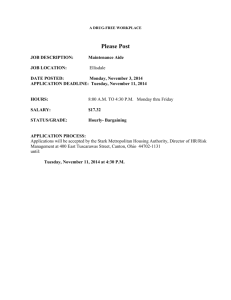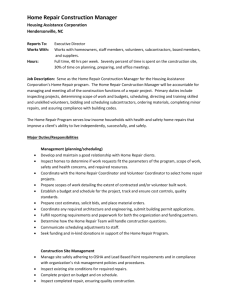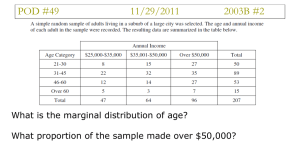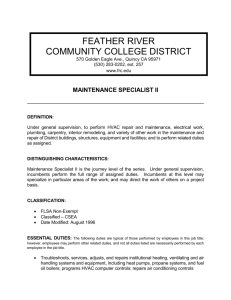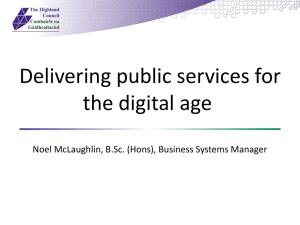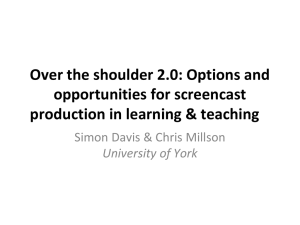lesson plan
advertisement
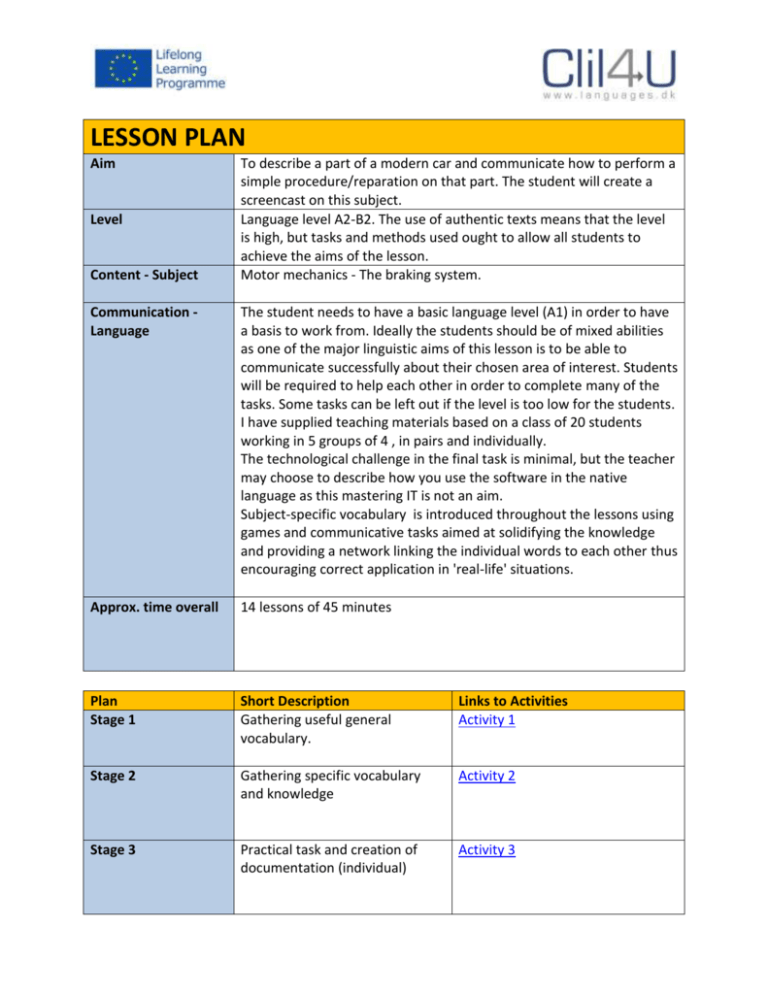
LESSON PLAN Aim Level Content - Subject To describe a part of a modern car and communicate how to perform a simple procedure/reparation on that part. The student will create a screencast on this subject. Language level A2-B2. The use of authentic texts means that the level is high, but tasks and methods used ought to allow all students to achieve the aims of the lesson. Motor mechanics - The braking system. Communication Language The student needs to have a basic language level (A1) in order to have a basis to work from. Ideally the students should be of mixed abilities as one of the major linguistic aims of this lesson is to be able to communicate successfully about their chosen area of interest. Students will be required to help each other in order to complete many of the tasks. Some tasks can be left out if the level is too low for the students. I have supplied teaching materials based on a class of 20 students working in 5 groups of 4 , in pairs and individually. The technological challenge in the final task is minimal, but the teacher may choose to describe how you use the software in the native language as this mastering IT is not an aim. Subject-specific vocabulary is introduced throughout the lessons using games and communicative tasks aimed at solidifying the knowledge and providing a network linking the individual words to each other thus encouraging correct application in 'real-life' situations. Approx. time overall 14 lessons of 45 minutes Plan Stage 1 Short Description Gathering useful general vocabulary. Links to Activities Activity 1 Stage 2 Gathering specific vocabulary and knowledge Activity 2 Stage 3 Practical task and creation of documentation (individual) Activity 3 Evaluation Back to Top The students are evaluated during the activities on how they have: demonstrated their social abilities (working in groups and sharing information) demonstrated their gained knowledge in the chosen area demonstrated their practical ability to use the gained knowledge. communicated the gained knowledge to others. Activity 1 Procedure The students have to find out what simple car parts are called in both BrE and AmE and what various tools are called in English (BrE). They will also hear an American talking about tools and will have to find examples of the difference between the two languages. Song: 'I'm in love with my car' by Queen The lesson starts with a simple listening task where the students, in pairs, have to piece together the lyrics as they hear the song. Brainstorm: CAR WORDS - what car words are there in the song? What other words do you know? These words should remain on the board and can be added to during the lesson. Worksheet: (Optional) - Car parts A very basic worksheet where students are given the names of basic car parts and then have to match the words and pictures finally find the words in a word search grid. Consolidation: (Optional) in groups of four play Car parts Bingo. Students choose a bingo card and take turns to be the caller, picking the car parts from the pool of cards placed in the middle of the table. If you have a picture of the car part read out you may cover it. The winner is the student who covers the whole card first. Finding groups: What is this? Students are given a card with a picture of a tool and have to circulate in the classroom asking each other 'What is this?' then exchanging the cards. They should be informed that it is ok for the answer to be 'I don't know'. After approximately 5 minutes the teacher says STOP. The cards have different colours on them students now have to assemble according to the colour on their card (Yellow, orange, red, blue and purple). Group task: Finding tools. The groups are given a task sheet on which the task is explained. Each group has to make a poster for the wall with a selection of tools on it. These posters have to be presented to the class by the group. The students should use a search engine to find the tools. Consolidation: Students play memory tools. In their groups the students take turns to turn over two cards in an attempt to match a picture and the written name of the tool. Film: See the youtube video about the tool box. Discuss the film content and language in class - find AmE words. Group task: Describe your ideal tool box. What tools would you choose? What make? In the group the students have to decide on a 10 tools that they would have in their tool box and a reason for their choice. The final choice is presented to the class. Approx. time Level Learning outcome Indicators Materials Final task: (Optional) Kim's game. The students have two minutes to study a collection of tools which is then hidden. They then have 5 minutes to remember all of the tools. This task can also be used as a warm-up in another lesson at a later stage. You can also repeat the What is it exercise so that students can see how much they have learnt. 3-4 45 minute lessons A1-A2 Getting used to speaking in front of the class Using the internet to gather information/vocabulary Acknowledging and recognising different forms of English Students using English as a classroom language Correctly identify different tools Song lyrics Worksheets: Car parts Tool poster Games: Memory tools Car parts Bingo What is this pictures Film: Eric the car guy's tool box Additional materials: A selection of tools (for Kim's game.) Activity 2 Procedure The students talk about basic repairs on a car, adding to their vocabulary. They read about a simple repair in groups and in pairs work on writing a description of a procedure. Brainstorm: Repairs The teacher elicits vocabulary which is collected on the board. When the teacher feel that there is enough she asks the students about the repairs that they like and don't like doing. Strong students are encouraged to give reasons. Reading: In pairs read the text '10 repairs'. Each pair is assigned a repair to talk about and should justify its placing on the list. If they think that it should be removed then they should have an alternative. Class discussion about the list. Consolidation: Game my garage. Each pair now has to choose a name for their garage. They have to make a price list for six repairs that could be made in a typical garage. Each repair has to have a number from one to six. Prices should be set to either £ or US$. With the teacher setting an appropriate exchange rate. Each person gets the list of repairs sheet. The couple take it in turns to service customers and go out and get their own cars serviced at other garages. Repairs are done according to a role of the dice - the customer rolls a one then the repair that is numbered one on the price list is written down, cost noted. After the teacher is sure that everyone has had at least one repair done the game is stopped and the students are asked what they have had repaired, where they had the work done, how much they paid etc... The questions should be varied according to the student's individual abilities. Writing: In pairs students now have to choose a procedure that they feel they are comfortable explaining and make a HOW TO. This can be made in the form of a wikki, a blog or just a simple word document. They should be encouraged to use pictures. Application: Students swop descriptions and attempt to follow the instructions. They are not allowed to add steps, therefore have to follow the instructions exactly. Afterwards they have to give the creators feedback and the description has to be corrected. In order to assure a mixture of procedures the teacher may have a list of procedures that the students can either choose from or can be assigned. Approx. time Learning outcome 3- 4 45 minute lessons increasing vocabulary Communicating through writing Indicators Materials Back to Top following written instructions Students debate use of particular vocabulary Students are able to create and follow simple instructions Text: 10 repairs Dice - one per pair. Repair sheet: Vehicle Repair Log Activity 3 Procedure The students read about the braking system, use their knowledge to examine and make a simple repair on it and make a screencast as documentation. Finding groups: Did you know? The students get a card with a statement on it and circulate around the classroom reading and swopping the cards. After approximately 5 minutes the teacher says stop and the students are asked to look at the number on their card. The number represents a group, they have to assemble in that group, but must keep hold of their card. They will be dealt in to 5 groups of 4 Brainstorm: BRAKES. In their groups the students have to brainstorm on words to do with the brakes and the braking system. There are no wrong answers, but choices have to be justified. When the teacher judges that each group has a number of words they have to take turns in writing one of their words on the board. This activity should continue until all of the words that the groups have generated are on the board. Other groups may comment/question the words as may the teacher, who may also add key vocabulary if she deems it necessary. Reading: Each group receives a text and questions on one particular aspect to do with the brakes. They have to read it and answer the questions insuring that everyone in the group understands and can share the information. The texts cover: 1. Introduction and ABS 2. Drum brakes 3. Disc brakes 4. the hydraulic system 5. Braking faults Sharing: When the groups are ready then they look at their number card. They should have different colours and now have to make 4 groups of 5. In their new groups they have to explain what they read, so that the whole group now knows all of the information. Consolidation: The students return to their original groups. Here they get a challenge; they have to match words with definitions. The words are taken from the texts. Screencasting: The teacher introduces the concept of a screencast. Demonstrating the on-line tool Screencast-o-matic. Each student is now asked to try out the tool using the procedure that they worked on previously. Final task: When the students are comfortable with the tool then she will explain to them what is required of them for the final task. She may then show a demonstration screencast. Finally they are given the task on a piece of paper. Now they have to go to the workshop and take pictures and gather information. When they are ready to make Approx. time Learning outcome Indicators Materials Back to Top their screencast they should be shown to a quiet place where they can record in peace. 6 45 minute lessons Reading technical English Re-telling gained knowledge gathering specific information about the brakes Students ability to talk and work with the brake system Did you know (print on 4 different colours of card) Texts Questions to texts Matching words Screencast-o-matic Demo screencast
